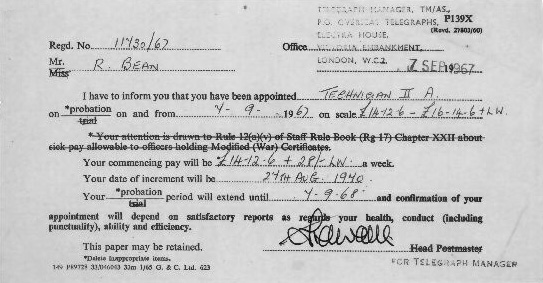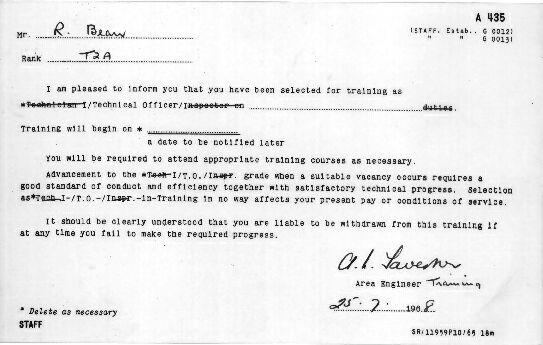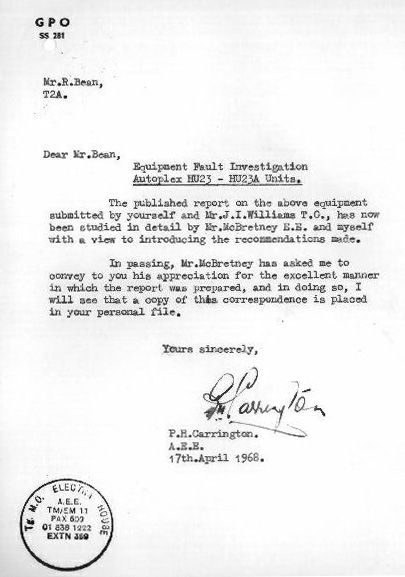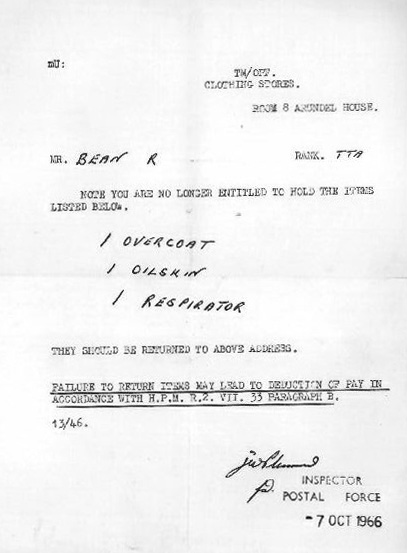|
|
||||
|
|
||||||||||||||||||||||
|
These memories are thanks to Rodger Bean :- ZCZC Here is a précis of my time with the External Telecommunications Executive. I still have the actual course notes, so if, for example, anyone wants to know how to service a Creed type 7, I could send them a copy. I even have some notes on the Marconi HU21s and Hasler Eltor. From my time at Civil Aviation which came after E.T.E., I have a set of course notes from C.A.S.T.E. (Civil Aviation Signals Training Establishment), which was at Bletchley Park, covering the TMC MCVT system. I have also noticed a tendency to begin to recall things I thought I had forgotten about staff, buildings etc. The ETE (External Telecommunications Executive) and Electra House. I started with ETE at Electra House in September 1964. Along with a bunch of other young lads I was introduced to our training officer, a stout man whose name I cannot recall, but I do remember that his secretary’s name was Tania. He summed up our responsibilities by saying, “Do as I say not as I do”. Our group of trainees was then shown to Arundel House, which was adjoining the Western end of Electra House, to collect our issue of dust jackets etc. My starting pay was about £7-0-0 per week and one of the first things I saved up for was a new AVO Mk8, which cost me about £30-0-0. The training course had been changed in the recent past from a 2 year one to a 3-year course. One reason was to broaden our knowledge by including some experience with the Telephony side of the GPO. I spent some time at Loughton Telephone exchange, which had only recently been upgraded from a manual exchange to a 4000 series Strowger exchange. In fact the old manual board was still in the process of being scrapped. The exchange had a rotary ringing generator, traditional test desk, and dual 50v battery. The master clock was a pendulum type with a pulsed electromagnetic maintaining system. And the building was of the older style combined PO and exchange in red brick with the Post Office fronting the High Street. From there I moved to an old exchange in the Walthamstow area. This one was so old that it was, I think pre 2000 series equipment. (The two motion selectors used gravity return on the vertical motion and had curved dark green or grey covers). The rack wiring was rubber insulated and had all perished. It was so brittle that any fault wires were just cut at each end, without disturbing the rest of the wiring, and then a new length of wire was run in to replace it. At this exchange I did “subs apps” (subscriber apparatus maintenance) and store keeping. I then went to somewhere in the Wansted-Ilford area to go with the “poles & holes” crews. In those days a three-man crew was used to erect poles up to the 45-foot, light grade. The only lifting gear was the three-section extension ladder and ropes and the holes were dug by hand! About this time I was on the crew doing the change from the manual to the automatic exchange at Hainault. This involved threading twine through all the line fuses down to broom handles, so that with a one person per handle all the line fuses on the manual exchange could be pulled simultaneously. During my time with the Telephone division I did the LTE (Line Termination Equipment?) training course. This covered everything from the subscribers telephone up to and including the exchange. The telephone installation section was held somewhere near Notting Hill Gate. The overhead cabling and pole erection was held somewhere in NE London, near the North Circular Road. Due to a clerical error I spent about twice as long as I should have done in the Telephone division. Back at Electra House I went on several training courses, most of which were held at 41- 46 Featherstone Street, EC1, just near Old Street underground station. On the opposite side of the road was a training school for banking staff (which bank? - sorry, local joke). We would occasionally shout and gesticulate across the street. The courses were workshop practice where we were taught basic metalwork, and made some of our own hand tools. Then later on there was the “A” course, which was based on the City & Guilds technician’s course 49, with a bias (pardon the pun) towards Telegraphy. In addition there was the ARQ course, which covered the principles of the Teleprinter over Radio system. Which was followed by the Hasler Eltor equipment course. There were two other courses (relay and uniselector adjustment), which were held in nearby Paul Street EC2, which we were already familiar with as Featherstone Street only had a tearoom and we used the Paul Street canteen for lunch. Featherstone St was run by ETE and Paul St by the Telephone division of the GPO (LTR). The only staff member I remember from Featherstone St was Ken Ernshaw, who taught among other things Morse code and keyboard. Ken had served on MTBs (Motor Torpedo Boats) during the war and would occasionally relate some of his wartime experiences. |
||||||||||||||||||||||
 |
||||||||||||||||||||||
|
On 7/9/67 I was appointed as a Tech 2A on probation, at a starting rate of £14.12.6d rising to £16.14.6d. |
||||||||||||||||||||||
 |
||||||||||||||||||||||
|
I also received notification on 25/7/68 of selection, at a later date yet to be notified, for training as a Technical Officer (TOiT). |
||||||||||||||||||||||
|
Not all of my time after completing my training was spent at E.H. Some time was spent at St Botolphs, where the Hasler ELTORs were being installed. Also at St Botolphs were a large number of recently commissioned MCFT systems, some of which were made by TMC. I was to encounter these again when I was working at Bletchley Park for the Board of Trade (Civil Aviation). This was all in the top floor of the building whose location I forget, except that it was within walking distance of Liverpool Street station. Also I recall a day visit to Cardinal House to see the equipment there, including the Philips TMBO that was a magnetic tape TTY buffer. It used ¼” magnetic tape in an endless loop, housed in a Perspex box on the front of the machine. I recall one of the maintenance techs complaining that Philips changed from +ve logic to -ve logic, and did this in the middle of a circuit! Another place I worked at for a few weeks was a sort of ETE outstation located in Livonia Street W1. That was interesting for a young lad, walking from the underground station through Soho! The TO in charge was a motor bike enthusiast. He used to tune and race Bantam motorbikes. Whilst a Tech 2A at E.H. I worked in teleprinter maintenance, mainly on the Creed type 7s, and also TDMSs (Telegraph Distortion Test Set), which were made by ATE of Bridgenorth. The TDMSs were used to check the performance of teleprinters and tape readers. I also had the chance to observe the old Morse circuits, which were still operational. Part of the Morse systems was on the third floor, I think, at the eastern end of the building, and comprised of a rack of STC equipment. I can’t quite recall what the STC equipment was although it did use valves and a pair of carpenter polarised relays per channel/cct. So I suspect they were part of the old Morse undersea cable system, as having two relays per cct suggests that cable code was being used. There were still some transatlantic Morse ccts working, including a 12 channel mechanical multiplexer, driven I think, by a 1kHz phonic motor. This part of the Morse system was somewhere closer to the ground floor. Also in the eastern end of the third floor were the MCVFT systems. These I recall used KT66 valves and were aligned using a test set mounted on a trolley. The test set was a tunable voltmeter, sort of a forerunner to the spectrum analyser. It could be tuned to the mark or space frequency of the channel to check for correct tuning, and could also observe the centre frequency if a signal with 50% mark/space ratio was sent. On I think the fifth floor was the mechanical workshop. Where I recall watching a rebuild of one of the rotary multiplexer switches from the old mechanical Hasler TORs. I can only remember one of the staff by name, he was a South American gentleman named Ven Zornosa. There was also a heavy mech workshop in the basement, where they did welding and sheet metalwork, amongst other things. Also on the fifth floor was the wire photo section the wire photo machines of which I think there were three pairs, comprised one transmit and one receive section per pair. Each section had one small lathlike machine in a lightproof box and a six foot 19” rack full of electronics. In the transmitter section, the lid of the “lathe” would be opened, exposing a drum. The picture to be sent would be wrapped around the drum of the “lathe” and the lid closed. The circuit to the receiving end would be established and a synchronising signal sent. When the receiver’s drum was syncronised the picture would be transmitted. This was done using an amplitude modulated audio tone over a phone line. At the receiving end this modulated audio tone would be demodulated, and used to control the brightness of a lamp. The drum of the receive machine would have an unexposed negative wrapped around it. After the transmission was finished the lightproof box, with the now exposed film would be removed, and it was then taken to the darkroom, which was at the far end of the room. The developed film would be printed and sent by motorcycle “delivery boy” to the recipient, usually one of the Fleet Street newspapers. Even back in the 1960s this equipment was so old that Muirheads, the manufacturers, didn’t have any technical information on them. Their pre war records had been destroyed in a bombing raid! |
||||||||||||||||||||||
 |
||||||||||||||||||||||
|
Most of the time as a TOiT I was in ARQ maintenance, which was on the third floor of E.H.. The electromechanical TORs had just been decommissioned and scrapped, and the Marconi HU21s were the only operational TORs. These, unlike the old Haslers were all electronic. Apart that is for the output relay, which was upgraded to an electronic one. These HU21s were decommissioned about the time I resigned. I believe one of them was donated to the London Science Museum. Here a letter of thanks for a job well done. |
||||||||||||||||||||||
|
My Colleagues I don’t remember many of my colleagues from that time, those that I do were, John Williams, who I assisted on a couple of technical investigations. Des Brideson and Nicolas Platreides, these were all TOs I think. Des was a keen Judo student and Nicolas Platreides (I hope I have spelt his name correctly) organised the section Christmas dinner one year at a Greek restaurant. The others I can remember but not by name are: One young (mid to late 20s) man who had a scar on his upper lip, rumored to have been caused by a soldering iron. He also had a petite wife who was occasionally asked, to her annoyance, when buying a bus or train ticket if that was adult or child. There was also an older (to a mere 19 year old) quiet man, who would always start his day with a cuppa and the newspaper. There were two younger guys on the third floor. Alan Paul, who had been a trainee just before the change from 2 year traineeship to 3, and there was another TO of a similar age nicknamed Yogi Bear. Looking at the St. Botolph's web page of International Telegraphs with a picture of two staff at St Botolphs taken in 1978, Ron Sydney’s face looks familiar but I don’t recall anything about him.
|
||||||||||||||||||||||
 |
||||||||||||||||||||||
|
In those days, the GPO was very strict about the issue and later return of stores items issued to staff. |
||||||||||||||||||||||
|
On 16/06/69 I transferred to the Board of Trade (Civil Aviation), and remained on loan to them until 31/03/72, at which time I officially resigned from The GPO or as it had then become, The PO. As one of my friends used to say “We were demoted from God’s Poor Orphans to just Poor Orphans.”. Rodger Bean +++++++ NNNN
|
|
[Home] [A Tribute to Jeff] [Memory Lane] [EHRCA History] [John Reeve] [Clive Clifton] [Gary Reynolds] [Rodger Bean] [Electra House Old & New] [Control Room] [MRC] [St Botolphs] [Brent ITLMS] [Fleet Building] [International Data Centre] [TRC] [COI] [News and Views] [EH Retired Colleagues Assoc.] [Links & Contacts] [Impressum] |